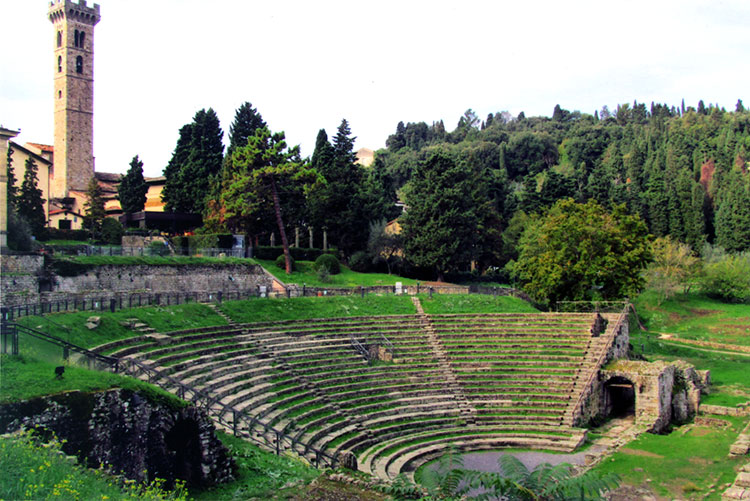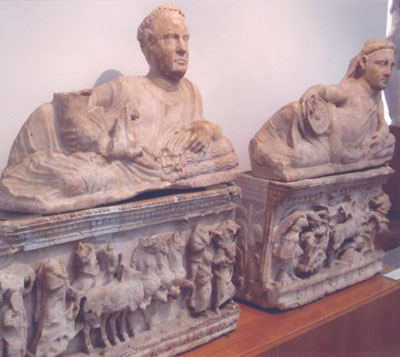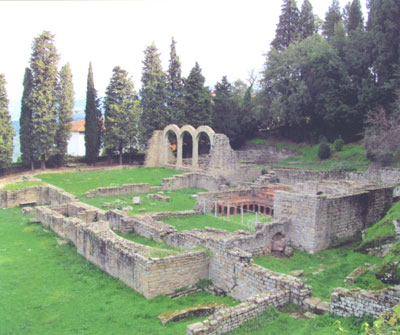Before Florence
This item appears on page 60 of the May 2013 issue.
(Second of two parts on Italy)
Long before Florence existed, there was Fiesole high in the hills above the Arno River. The Etruscans dominated central Italy centuries before the Romans with settlements as far north as Parma and Bologna and as far south as Naples. One of their settlements, perhaps dating from the eighth century BC, was Fiesole, which they called Vipsul or Visl and which the Romans — much later — called Faesulae.
Fiesole probably began as a small religious center consisting of a few sanctuaries and gradually developed over the centuries into a city. By the first century BC, the Romans had settled nearby with an encampment in the valley beside the Arno River only about five miles below Fiesole. From this camp they conquered the Etruscan city in about 90 BC.
Gradually, a Roman city replaced the Etruscan one — or almost replaced this, since Etruscan walls and buildings were sometimes reused and built over.
Today much remains from Roman times and some from the earlier Etruscan period. The Archaeological Park housing them is located just five minutes from present-day Fiesole’s main square, Piazza Mino, itself built where the Roman Forum once stood. It’s an extremely beautiful location overlooking the surrounding countryside.
Tour of the ruins
The first structure one sees on entering the Archaeological Park is the Roman theater, built in the first century BC of stone quarried right from the rocky hillside where the theater is located. It consists of the cavea, tiered seating, divided by staircases providing access for spectators. At the bottom of the proscenium (stage) were rows reserved for dignitaries.
The theater could seat 3,000. Today Fiesole hosts a summer festival, the Estate Fiesolana, of music, dance, theater and cinema under the stars in this spectacular setting.
The Roman baths were located only a short stroll away from the theater. Built at about the same time as the theater or shortly thereafter, they consisted of two sections: an open area with a large pool and two smaller ones plus a covered area.
The open area also had a courtyard for gymnastics. The covered area had the typical Roman arrangement for baths: frigidarium with cool water, tepidarium with warm water and caldarium with hot water. Nearby were furnaces to heat the water, and communal latrines.
The baths were used not only for bathing but for exercise and as a meeting place for people to discuss the events of the day.
Roman over Etruscan
A 5-minute stroll from the baths leads to the temple area. There a Roman temple lies above an Etruscan one, and that, in turn, lies above an even older sanctuary, possibly from the seventh/sixth centuries BC.
The Etruscan temple, built in the fourth century BC, was small, consisting of a single room, the cella, with two side chambers called antae. It was roofed with terra-cotta tiles. An altar stood outside the entrance.
After the Romans destroyed this temple during their conquest of 90 BC, they built a larger temple over the Etruscan one. This one included a stoa, where pilgrims visiting the temple could rest themselves. The Romans, too, had an altar in front of the entrance.
When the Lombards invaded in the sixth and seventh centuries AD, they used the temple area as their necropolis. One of their stone tombs with a huge slab on top, probably “recycled” from one of the Roman buildings, lies gaping open beside the ruins of the Roman temple.
Fiesole recovered during the early Middle Ages only to be repeatedly sacked by Florence, its neighbor in the valley below, and finally conquered by Florence in 1125. Dante writing almost 200 years later refers to this conflict in his “Inferno.”
On-site museum
Fiesole’s archaeological site has a first-rate museum alongside, displaying objects from both the site, itself, and the surrounding area.
Highlights include the fifth-century-BC Stele Fiesolana, a funerary monument depicting banquet scenes (Room 1); a first-century-BC Etruscan bronze torso of a lioness, although it’s identified in the museum as a she-wolf (Room 3); the reconstruction of a seventh-century-AD Lombard tomb with its male occupant inside with his knife, ax and goblet (Room 5); a section of a fourth-century-BC Etruscan wall of massive stone blocks (Room 6), and the Costantini collection of Greek and Etruscan vases that also includes vases from the Greek colonies in Italy (Rooms I and II).
There’s also a beautiful, second-century-AD, Roman marble head of a woman that should not be missed in Room V.
The Archaeological Park & Museum (phone 055 59 118) are open daily 10 to 7 from Easter through October and 10 to 5 from November to Easter (except Tuesdays and Wednesdays). Admission is €10 (near $13). Call to verify hours.
Other sights
Fiesole has other sights that should not be missed if at all possible. The Bandini Museum, just across from the Archaeological Park and covered by the same admission ticket, has a small, superb collection of glazed terra-cottas by members of the Della Robbia family as well as medieval and Renaissance Tuscan paintings.
The Romanesque cathedral, just off Piazza Mino, dates from the 11th century and has a 13th-century bell tower. There is a raised choir over a crypt with the altar of St. Romulus, Fiesole’s first bishop, to whom the cathedral is dedicated.
It’s a tough uphill climb from the cathedral to the Monastery of San Francesco, a 14th-century church built on top of a medieval fortress destroyed by the Florentines in 1125. This hill was once the Etruscan, and, later, the Roman, acropolis. The view over Florence is panoramic.
Scattered around Fiesole and the vicinity, you will see sections of the massive Etruscan walls, especially outside the archaeological zone behind the Roman baths.
If you go…
You can reach Fiesole by taxi from Florence (approximately €20, or $26, each way) or you can take the No. 7 bus from Piazza San Marco in Florence. The bus runs every 15 minutes. The trip takes about 20 minutes, delivering you to the Piazza Mino steps from the Archaeological Park. The bus ticket costs €2 each way.
A super way to reward yourself after three or four hours in Fiesole is to have lunch at the superb Ristorante La Reggia degli Etruschi (phone/fax +39 055 59385, www.lareggiadeglietruschi.com) at Via San Francesco, the steep street leading up to the Monastery of San Francesco. If it’s warm enough, request a table on the terrace. The view is fabulous, the food even more so.
Lunch for two with two glasses of Prosecco and two glasses of Chianti Classico, and tip, cost €105 ($137). Reserve in advance.



